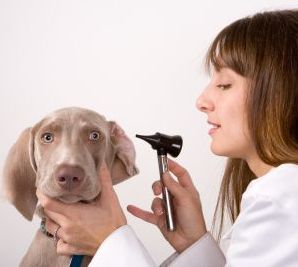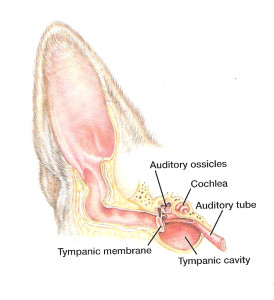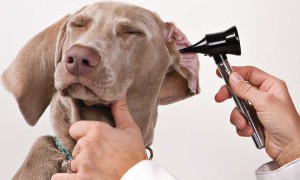 Canine ear infections are most commonly caused by bacteria or yeast. Ear mites, excessive hair, moisture or wax, foreign bodies, allergies, and hypothyroidism can all be contributing factors in the development of an ear infection. Because the ear canal in dogs is mostly vertical (unlike a human ear canal that is horizontal), it is easy for debris and moisture to be retained in the ear canal.
Canine ear infections are most commonly caused by bacteria or yeast. Ear mites, excessive hair, moisture or wax, foreign bodies, allergies, and hypothyroidism can all be contributing factors in the development of an ear infection. Because the ear canal in dogs is mostly vertical (unlike a human ear canal that is horizontal), it is easy for debris and moisture to be retained in the ear canal.
How Can I Tell if My Dog Has an Ear Infection?
The following symptoms may indicate that your dog needs to have his ears checked by a veterinarian:
- Scratching of the ear or area around the ear
- Brown, yellow, or bloody discharge
- Odor in the ear
- Redness
- Swelling
- Crusts or scabs on inside of the outer earHair loss around the ear
- Rubbing of the ear and surrounding area on the floor or furniture
- Head shaking or head tilt
- Loss of balance
- Unusual eye movements
- Walking in circles
- Hearing loss
- Which Dogs Are Prone to Ear Infections?
Dogs with allergies or those with non-erect outer ears can be predisposed to developing ear infections. Dogs that have excessive hair growth in the ear canal may also be more susceptible to ear infections.
How Are Ear Infections Diagnosed?
 A veterinarian can usually diagnose an ear infection by examining the ear canal and ear drum with a magnifying ear cone similar to devices used on people. This may require sedation, especially if the dog is very painful. A sample of ear discharge may be examined to look for bacteria, yeast, and parasites. If a bacterial infection is suspected your veterinarian may send a sample of the ear discharge to a laboratory to see what bacteria is causing the infection. Other diagnostics may be done (such as checking for an underactive thyroid) if your veterinarian feels they are indicated. Because there are multiple causes and contributing factors that cause ear infections in dogs, it is important that an accurate diagnosis is obtained by your veterinarian.
A veterinarian can usually diagnose an ear infection by examining the ear canal and ear drum with a magnifying ear cone similar to devices used on people. This may require sedation, especially if the dog is very painful. A sample of ear discharge may be examined to look for bacteria, yeast, and parasites. If a bacterial infection is suspected your veterinarian may send a sample of the ear discharge to a laboratory to see what bacteria is causing the infection. Other diagnostics may be done (such as checking for an underactive thyroid) if your veterinarian feels they are indicated. Because there are multiple causes and contributing factors that cause ear infections in dogs, it is important that an accurate diagnosis is obtained by your veterinarian.
How Are Ear Infections Treated?
Most commonly, ear infections can be treated with a professional cleaning followed by medication given at home. Your veterinarian may prescribe topical and/or oral medicine. It is not uncommon for some dogs to have recurrent ear infections.
Ear Infections in Dogs: Symptoms and Treatment
 How Can Ear Infections Be Prevented?
How Can Ear Infections Be Prevented?
- Check your dog’s ears regularly for abnormal discharge, odor and/or redness
- If your dog’s outer ear appears dirty, clean gently with a cotton ball dampened with a solution suggested by your veterinarian. Your veterinarian can make recommendations on how frequently you should clean your dog’s ears.
- After baths and swimming, be sure to dry your dog’s ears thoroughly.
- If your dog has excessive hair in the outer ear canal, it should be removed. A groomer can do this, or you can ask your veterinarian to show you the proper technique for removing the hair.
When Is It Time to See the Vet?
If your dog is showing any of the symptoms described above, he should be seen by a veterinarian as soon as possible. Ear infections can be very painful and if left untreated can harm both the ear canal and middle ear.
WWR Reference from ASPCA Virtual Pet Behaviorist
